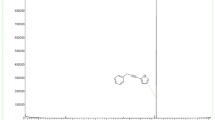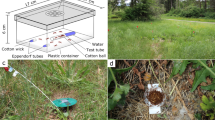Abstract
Macfadyena unguis-cati (L.) Gentry (Bignoniaceae) was introduced as an ornamental in South Africa, but is fast becoming an important invasive plant in many areas. It is difficult to control the plant chemically and mechanically. The first biocontrol agent, the chrysomelid Charidotis auroguttata (Boheman), has been released. It established at some release sites, but numbers have so far remained low. Additional biocontrol agents were sought to augment C. auroguttata. The potential host ranges of two foliage feeding lace bugs, Carvalhotingis visenda (Drake and Hambleton) and C. hollandi (Drake) (Hemiptera: Tingidae) were evaluated on the basis of nymphal no-choice and adult multi-choice tests involving 23 plant species in 11 families. In no-choice tests, nymphs of both species were able to survive and complete development on M. unguis-cati only, and adults of both species only fed and oviposited on M. unguis-cati during the adult multi-choice tests. Host specificity tests thus confirm that the tingids are highly host specific biocontrol agents, and will not pose risk to any non-target plants in South Africa. A study to determine the potential impact of C. hollandi nymphal feeding on M. unguis-cati showed a significant decrease in the chlorophyll contents of leaves when compared to those of control plants. These studies indicate that, once released, the two lace bug species could contribute significantly to the biological control of M. unguis-cati in South Africa.




Similar content being viewed by others
References
Anonymous (2005) Control of unwanted plants: a guide to the use of herbicides registered for the control of declared weeds, invader and other problem plants. Copper Sunset Trading 100 (Pty) Ltd., Glenstantia
Baars J-R, Neser S (1999) Past and present initiatives on the biological control of Lantana camara (Verbenaceae) in South Africa. Afr Ent Mem 1:21–33
Briese DT (1996) Potential impact of the stem-boring weevil Lixus cardui on the growth and reproductive capacity of Onopordum thistles. Biocontrol Sci Tech 6:251–261
Cilliers CJ (1987) Notes on the biology of the established insect natural enemies of Lantana camara L. (Verbenaceae) and their seasonal history in South Africa. J Entomol Soc Southern Afr 50:1–13
Cochran WG, Cox GM (1967) Experimental designs. Wiley, New York, USA
Conrad KA, Dhileepan K (2007) Pre-release evaluation of the efficacy of the leaf-sucking bug Carvalhotingis visenda (Heteroptera: Tingidae) as a biological control agent for cat’s claw creeper Macfadyena unguis-cati (Bignoniaceae). Biocontrol Sci Tech 17:303–311
Csurhes SM, Edwards R (1998) Potential environmental weeds in Australia: candidate species for preventative control. Queensland Department of Natural Resources, Brisbane
Denoth M, Frid L, Myers JH (2002) Multiple agents in biological control: improving the odds? Biol Control 24:20–30
Dhileepan K, Trevino M, Snow EL (2007) Specificity of Carvalhotingis visenda (Hemiptera: Tingidae) as a biological control agent for cat’s claw creeper Macfadyena unguis-cati (Bignoniaceae) in Australia. Biol Control 41:283–290
Everett TH (1980) The New York botanical garden illustrated encyclopaedia of horticulture. Garland Publishing, Inc., New York
Henderson L (2001) Alien weeds and invasive plants. Plant Protection Research Institute Handbook No 12. Agricultural Research Council, Pretoria, RSA
Holm LG, Pancho JV, Herberger JP, Plucknett DL (1991) A geographic atlas of world weeds. Krieger Publishing Company, Malabar, FL, USA
McClay AS, Balciunas JK (2005) The role of pre-release efficacy assessment in selecting classical biological control agents for weeds - applying the Anna Karenina principle. Biol Control 35:197–207
McEvoy PB, Coombs EM (2000) Why things bite back: unintended consequences of biological weed control. In: Follet PA, Duan JJ (eds) Nontarget effects of biological control. Kluwer Academic Publishers, Boston, MA pp 167–194
Meyer JY (2000) Preliminary review of the invasive plants in the pacific islands (SPREP member countries). In: Sherley G (ed) Invasive species in the pacific: a technical review and draft regional strategy, South Pacific technical environment programme, Samoa, pp 85–114
Myburgh AC, Rust DJ (1986) Stinkbugs, lacebugs and leafhoppers. In: Myburgh AC (ed) Crop pests in southern Africa: deciduous fruit, grapes and berries, vol 407. Plant Protection Research Institute, Department of Agriculture and Water Supply Bulletin, pp 59–61
Myers JH (1985) How many insect species are necessary for successful biocontrol of weeds? In: Delfosse ES (ed) Proceedings of the 6th international symposium on the biological control of weeds, Agriculture Canada. Canadian Govt. Printing Office, Ottawa, pp 77–82
Neser S (1996) Cat’s claw creeper nipped in the bud. Agric News p7, Pretoria, RSA
Pearson DE, Callaway RM (2005) Indirect nontarget effects of host-specific biological control agents: implications for biological control. Biol Control 35:288–298
Raghu S, Dhileepan K, Triviño M (2006) Response of an invasive liana to simulated herbivory: implications for its biological control. Acta Oecol 29:335–345
Sheppard AW (2003) Prioritizing agents based on predicted efficacy: beyond the lottery approach. In: Jacob HS, Briese DT (eds) Improving the selection, testing and evaluation of weed biological control agents, CRC for Australian Weed Management, Glen Osmond, Australia, pp 11–21
Wapshere AJ (1974) A strategy for evaluating the safety of organisms for biological weed control. Ann Appl Biol 77:201–211
Williams HE (2002) Life history and laboratory host range of Charidotis auroguttata (Boheman) (Coleoptera: Chrysomelidae), the first natural enemy released against Macfadyena unguis-cati (L.) Gentry (Bignoniaceae) in South Africa. Coll Bull 56:299–307
Acknowledgements
Several organizations provided financial support, including National Department of Agriculture, Department of Water Affairs and Forestry and the Agricultural Research Council of South Africa. Opportunistic searches for natural enemies were done with some financial support from the Queensland Department of Natural Resources and Mining, Australia. The authors would like to thank PPRI staff for some identifications; Thomas J. Henry, Research Entomologist, Systematic Entomology Laboratory, Agricultural Research Service, US Department of Agriculture, Beltsville, Maryland, USA, for identification of C. visenda and C. hollandi; Dr C.L. Bellamy, Principal Specialist on New World Buprestidae, Plant Pest Diagnostic Laboratory, California Department of Food and Agriculture, Sacramento, California, USA, for identification of H. (Hedwigiella) jureceki; M. Alma Solis, Research Entomologist at the Systematic Entomology Laboratory, Agricultural Research Service, US Department of Agriculture, Beltsville, USA, for identification of H. pyrochroma; and C. O’ Brien for identification of A. notatus.
Author information
Authors and Affiliations
Corresponding author
Rights and permissions
About this article
Cite this article
Williams, H.E., Neser, S. & Madire, L.G. Candidates for biocontrol of Macfadyena unguis-cati in South Africa: biology, host ranges and potential impact of Carvalhotingis visenda and Carvalhotingis hollandi under quarantine conditions. BioControl 53, 945–956 (2008). https://doi.org/10.1007/s10526-007-9107-z
Received:
Accepted:
Published:
Issue Date:
DOI: https://doi.org/10.1007/s10526-007-9107-z




